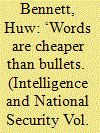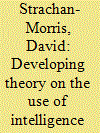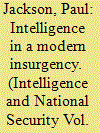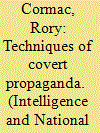| Srl | Item |
| 1 |
ID:
168613


|
|
|
|
|
| Summary/Abstract |
Psychological warfare, the use of propaganda to aid military operations, acquired prominence in British strategy in the early Cold War Middle East. This article argues planning made limited progress until the 1956 Suez crisis. Suez produced optimism about propaganda’s ability to address threats from Egypt, the USSR and the Yemen. In Oman, Aden and Cyprus, psychological warfare was practiced to demoralise enemies, bolster allies and counter smears about British conduct. Only mixed results ensued though, and doubts about the military’s involvement in propaganda lingered. Psychological warfare endured because it was a cheap option that might sometimes work, and could induce opponents to surrender rather than fight on.
|
|
|
|
|
|
|
|
|
|
|
|
|
|
|
|
| 2 |
ID:
168615


|
|
|
|
|
| Summary/Abstract |
What does it take to cultivate spies inside an adversary’s forces? I assess efforts by the United States and South Vietnam to penetrate the Viet Cong during the Vietnam War. I offer the first extended account of the United States’ most successful intelligence penetration of the conflict. After initial recruitment by South Vietnam, a mid-level Viet Cong cadre spied for the CIA from 1969 until the end of the war. U.S. experience in this episode and others in Vietnam points up a challenge. Local allies offer expertise in identifying potential informants. But prospective spies view U.S. intelligence as more trustworthy and legitimate than local agencies with dubious operational security.
|
|
|
|
|
|
|
|
|
|
|
|
|
|
|
|
| 3 |
ID:
168616


|
|
|
|
|
| Summary/Abstract |
This special section has its origins in the observation that in the intelligence and counterinsurgency literature insurgents tend to be treated as something that intelligence acts upon but rarely, if ever, treated as intelligence actors in their own right. A review of the literature and military doctrine on counterinsurgency highlights this gap and demonstrates the importance of studies such as those brought together in this special section of Intelligence and National Security.
|
|
|
|
|
|
|
|
|
|
|
|
|
|
|
|
| 4 |
ID:
168614


|
|
|
|
|
| Summary/Abstract |
This article uncovers a Caribbean Basin anti-communist intelligence network independent of the U.S. government and the international Cold War. Nicaraguan dictator Anastasio Somoza, Honduran dictator Tiburcio Carías, and Dominican dictator Rafael Trujillo characterized local democratic developments as communist threats to their regimes’ national security. With the 1947 Cayo Confites expedition and the 1948 Costa Rican Civil War, the military dictators coalesced into an informal network that increasingly shared intelligence. Joined by the Venezuelan military junta and Fulgencio Batista’s Cuban dictatorship, members nurtured a Caribbean Basin anti-communist domino theory characterising threats to one regime as a transnational danger to regional stability.
|
|
|
|
|
|
|
|
|
|
|
|
|
|
|
|
| 5 |
ID:
168620


|
|
|
|
|
| Summary/Abstract |
This article analyses intelligence assessment as performed by Hezbollah and Hamas and similar Violent Non-State Actors (“VNSA”). VNSA’s seek to inflict the highest level of harm on adversary states without provoking full-scale wars, which they avoid due to military asymmetry. Improved intelligence regarding a state’s cost/benefit analysis of unleashing full-scale war thus enables VNSA’s to “safely” calibrate operations to maximize harm. Such efforts might prove error-prone for three reasons: the authoritarian structure characterizing VNSAs; psychological bias regarding both self and enemy; and a “transparency fallacy” concerning target states. Assessments of Hezbollah (2006) and Hamas (2014) serve as case studies.
|
|
|
|
|
|
|
|
|
|
|
|
|
|
|
|
| 6 |
ID:
168621


|
|
|
|
|
| Summary/Abstract |
John N. Gentry argues that Violent Non-State Actors, such as insurgencies or terrorist groups, use intelligence in three ways. First and foremost, they employ intelligence to plan physical military attacks and to protect themselves from penetration and attack by government forces. Secondly, they use counterintelligence in order to ensure the survival of the insurgency and preserve the faith of their members by enforcing ideological discipline. Finally, they use information operations to shape their operational environments. This article seeks to determine what type of intelligence the Greek insurgents employed during the civil war and whether this insurgency fits Gentry’s model.
|
|
|
|
|
|
|
|
|
|
|
|
|
|
|
|
| 7 |
ID:
168618


|
|
|
|
|
| Summary/Abstract |
Outside some well-known movements like Al Qaeda, there is little understanding of how insurgent movements in the Global South gather, process and manage intelligence. This paper is based on fieldwork in Nepal with former members of the Maoist Army. The Maoists fought a secretive insurgency war for ten years, signing a peace agreement in 2006. Fieldwork involved former combatants, intelligence officers and Maoist cadres and analyses the intelligence methodology of the Maoist insurgency, placing this in to the context of Nepal Government operations. The Maoists benefited from poor opponents but they did establish an effective system of intelligence into operations.
|
|
|
|
|
|
|
|
|
|
|
|
|
|
|
|
| 8 |
ID:
168619


|
|
|
|
|
| Summary/Abstract |
In the 1980s some thirty members of paramilitary groups in Northern Ireland both republican and loyalist, agreed to provide evidence against their former colleagues in return for a reduced sentence or immunity from prosecution, a new identity and life. Such individuals became commonly known as ‘supergrasses’. This article drawing on archival and documentary research explores the potential opportunity these supergrass trials provided for republican paramilitary groups to gather open source intelligence on their loyalist counterparts. It also tracks whether individuals named by loyalist supergrasses were subsequently targeted by opposing paramilitary groups on their acquittal or release from prison.
|
|
|
|
|
|
|
|
|
|
|
|
|
|
|
|
| 9 |
ID:
168622


|
|
|
|
|
| Summary/Abstract |
In early 2019, the British government declassified a tranche of Information Research Department files. Among them is a candid and concise overview of British thinking about covert propaganda, complete with a list of examples of British forgery operations. This short piece transcribes the briefing note and provides an introduction. The document sheds new light on UK covert action, but also talks to ongoing scholarly debates in Intelligence Studies and International Relations more broadly.
|
|
|
|
|
|
|
|
|
|
|
|
|
|
|
|
| 10 |
ID:
168617


|
|
|
|
|
| Summary/Abstract |
The need to define intelligence is understandable because the secrecy surrounding it can almost make it appear too amorphous to study. In most definitions, the authors not only attempt to define what intelligence is but also who does it. Until recently the focus has been on the state with occasional focus on sub-state actors such as law enforcement agencies. After 9/11 there was a shift from the study of inter-state intelligence to the use of intelligence against non-state actors such as Al Qaeda. The literature still treated these non-state actors as something to be acted upon rather than intelligence actors in their own right. By examining the North Vietnamese use of intelligence during the Second Indochina War this article takes a step to redress that oversight. This article will discuss the North Vietnamese use of intelligence in the context of definitions of intelligence and intelligence actors and will use John Gentry’s proposed model of violent non-state actor intelligence as its analytical framework.
|
|
|
|
|
|
|
|
|
|
|
|
|
|
|
|